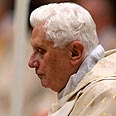
Vatican waited years to defrock Arizona priest
Church sex abuse scandal grows after Vatican papers suggest Pope Benedict XVI, while heading the Congregation of the Doctrine of the Faith, failed to laicize abusive priest despite bishop's pleas
Holy See in the hot seat: Did Pope Benedict XVI let an abuse case involving an Arizona priest languish at the Vatican for 12 years despite repeated pleas from the bishop for the man to be removed from the priesthood?
According to church documents, in the 1990s, a church tribunal found that Reverend Michael Teta of Tucson, Arizona had molested children as far back as the late 1970s. The panel deemed his behavior – including allegations that he abused boys in a confessional – almost "satanic." The tribunal referred his case to then-Cardinal Joseph Ratzinger, who would become pope in 2005.
But it took 12 years from the time Ratzinger assumed control of the case in a signed letter until Teta was formally removed from ministry, a step only the Vatican can take.
As abuse cases with the pontiff's fingerprints mushroom, Teta's case and that of another Arizona priest cast further doubt on the church's insistence that the future pope played no role in shielding pedophiles.
Actions of a 'satanic quality'
Teta was accused of engaging in abuse not long after his arrival to the Diocese of Tucson in 1978 and among the eventual allegations were those accusing him of molesting two boys, ages 7 and 9, in the confessional as they prepared for their First Communion.
Bishop Manuel Moreno held a church tribunal for Teta, which determined "there is almost a satanic quality in his mode of acting toward young men and boys."
Teta was removed from ministry by the bishop, but because the church's most severe punishment — laicization — can only be handed down from Rome; he remained on the church payroll and was working with young people outside the church.
At the time, Ratzinger headed the Congregation of the Doctrine of the Faith, the office that typically handled cases of abuse in confessionals. The church considers those more serious than other molestations because they also defile the sacrament of penance.
In a signed letter dated June 8, 1992, Ratzinger advised Moreno he was taking control of the case, according to a copy provided to the AP from Lynne Cadigan, an attorney who represented two of Teta's victims. Five years later, no action had been taken.
"This case has already gone on for seven years," Moreno wrote Ratzinger on April 28, 1997, adding, "I make this plea to you to assist me in every way you can to expedite this case."
It would be another seven years before Teta was laicized.
"There's no doubt that Ratzinger delayed the defrocking process of dangerous priests who were deemed 'satanic' by their own bishop," Cadigan said.
Another Tucson case that of Msgr. Robert Trupia, shows the fragmented nature of how Rome handled such allegations before 2001, when Ratzinger dictated that all abuse cases must go through his Congregation of the Doctrine of the Faith.
Before then, files were sent to varied Vatican departments, as they were in the case of Trupia. Moreno suspended Trupia in 1992, but again faced delays from the Vatican in having him formally removed from the church.
Paper trail
Documents show at least two Vatican offices — the Congregation for the Clergy and the Apostolic Signatura, the highest judicial authority of the Catholic Church — were involved in the case at least as early as 1995.
Moreno pleaded with the Congregation for the Clergy to do something, writing, "We have proofs of civil crimes against people who were under his priestly care" and warning Trupia could "be the source of greater scandal in the future."
Ultimately, the case landed in Ratzinger's office.
On Feb. 10, 2003, a day after the Arizona Daily Star reported that Trupia was living in a condo near Baltimore, driving a leather-seated Mercedes-Benz with a rosary hanging from the rearview mirror, Moreno wrote to Ratzinger again, calling him "a major risk factor to the children, adolescents and adults that he may have contact with."
There is no indication in the case files that Ratzinger responded. Trupia was laicized only in August 2004.
"The tragedy is that the bishops have only two choices: Follow the Vatican's code of secrecy and delay, or leave the church," Cadigan, the victims' lawyer, said Friday. "It's unfortunate that their faith demands that they sacrifice children to follow the Vatican's directions."
Fred Allison, a spokesman for the Roman Catholic Diocese of Tucson, defended the Vatican's handling of the Teta and Trupia cases. Internal church trials took years and the priests' appeals took years more, Allison said.
"There is no indication at all that the Vatican was delaying or dragging its feet," he said.










